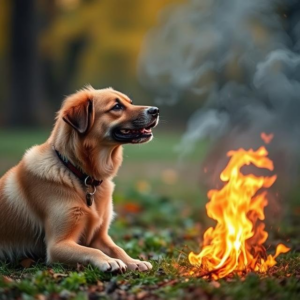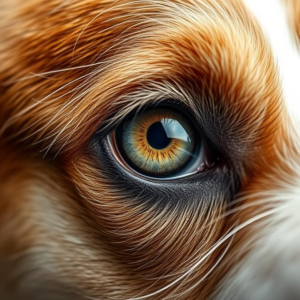If you’ve ever sat by a cozy fireplace or gathered around a campfire with your dog, you might have wondered, Can dogs see fire and know it’s dangerous? For every dog owner, it is an enthralling question. It leads to several possibilities that include how a dog interprets fire with its many senses and whether it will instinctively tell if there is danger associated with fire. Let us find out the reality from dog owner’s and veterinarian’s perspective.

Can Dogs See Fire?
Yes, dogs do see fire, although it is different from the way we do. Dogs have dichromatic vision. They tend to see the environment through shades of blue and yellow. They cannot see the brilliant reds and oranges of the flame with the same intensity as we do, yet the flickering light and motion of fire must be very apparent to them. Besides sight, the heat and smell of fire are tremendous considerations that figure into the dog sense and perception of fire.
A post by VCA Animal Hospitals says that dog’s vision is adapted to detect motion over color. The flickering and moving lights of the fire become very prominent in their sight. Although dogs may not view fire the same way as humans, their excellent motion detection remains an important factor leading them to see flames.
The ability to view and concentrate on motion could provoke the curiosity of dogs toward fire, especially if they have never experienced it before. Sight alone, however, does not determine whether fire makes it dangerous for them. Other senses as well as instincts come into play here.
Do Dogs Instinctively Fear Fire?
While it’s assumed that humans have an inborn fear of fire, dogs do not. Fire is not a natural predator in the wild, so dogs lack an instinct to avoid it. Many of the canine species exhibit cautious and fearful behavior around open flames. Why is this the case?
One reason is their high sensitivity to scents. While a human has about 5 million olfactory receptors, dogs have about 220 million. The foul odor of smoke and burning objects may be disturbing to dogs because it represents danger. It is also possible that their acute hearing is activated when crackling and popping sounds make them aware of flames.

The VCA Animal Hospitals article also notes that dogs’ reactions to stimuli, like fire, often depend on past experiences. For example, a dog that has encountered a distressing fire-related situation, such as a house fire, is more likely to develop fear. Conversely, curious dogs, particularly puppies, may approach flames out of intrigue, not realizing the potential danger.
Understanding Fire from a Dog Owner’s Perspective
Dogs heavily depend on their senses to assess their surroundings, which also applies to fires. Nonetheless, their understanding of fire as a danger is heavily influenced by learning and experience. A dog may associate discomfort with fire or a specific instance when it wandered too close and got too hot.
Most pet owners claim that their pets keep a natural distance from fire and candles. It is not some instinctive fear of fire but the combined effect of heat, smell, and strangeness. Conversely, some dogs—especially highly curious breeds or working dogs used to facing challenges—might see fire as something to investigate.
Fire safety is very important in dog training. Just as you teach your dog “leave it” when the object of the moment is dangerous, use the same principle to keep your dog away from fire.
Practical Tips to Keep Your Dog Safe Around Fire
Fire safety is as important for your furry friends as it is for the rest of the family. While dogs may detect fire’s heat or smell, they don’t always realize its full danger. Here are some practical steps you can take to keep them safe:
1. Train Fire Awareness Early
To ensure that dogs keep their distance from flames (including candles) or other sources of heat, work with them to learn the basic commands “stay” or “leave it.”
2. Supervise Around Open Flames
Whether you’re lighting a campfire, using a fireplace, or having dinner by candlelight, never leave your dog unsupervised around open flames. Curious sniffing or tail wagging could lead to accidents.
3. Secure Fireplaces and Stoves
Install a protective screen around fireplaces or wood-burning stoves to create a barrier. This prevents accidents while still allowing your dog to enjoy a warm space nearby.
4. Use Pet-Friendly Candles
If you’ve got a curious pooch, consider using flameless LED candles or keeping traditional candles entirely out of their reach.
5. Prepare for Emergencies
It is important to include your dog in your plan of fire safety. You should include your dog in fire drills while practicing evacuation and be certain to carry a leash or carrier for necessary purposes at all times.
The Unbreakable Bond Between Humans and Their Dogs
The beautiful thing about the relation between human beings and dogs is that they care mutually and protect each other. Just as dogs would sense fear and stress in humans, so too would they react to fire and barking when they see that their owners are panicked. There are numbers of cases where dogs alerted families to damn fires by barking their heads off until everyone got out.
Can dogs see fire and know it’s dangerous? The answer is a mix of yes and no. While dogs can visually detect fire and may respond to its heat, smell, and sound, they don’t naturally understand the full scope of fire’s danger. Their reactions are shaped by experience and training, making it crucial for owners to provide consistent guidance and supervision.
Previous